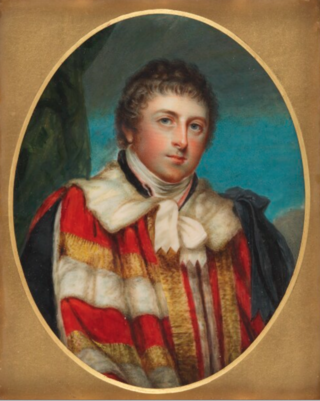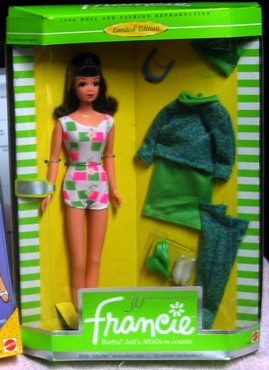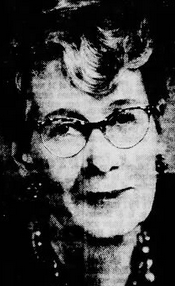Related Research Articles

A hairstyle, hairdo, haircut or coiffure refers to the styling of hair, usually on the human head but sometimes on the face or body. The fashioning of hair can be considered an aspect of personal grooming, fashion, and cosmetics, although practical, cultural, and popular considerations also influence some hairstyles.

Kings County is a county located in the U.S. state of California. The population was 152,486 at the 2020 census. The county seat is Hanford.
Polly Pocket is a toy line of dolls and accessories first founded and designed by Chris Wiggs in 1983 and licensed by Bluebird Toys from 1989 until both entities/properties were acquired by Mattel in 1998.

The beehive is a hairstyle in which long hair is piled up in a conical shape on the top of the head and slightly backwards pointing, giving some resemblance to the shape of a traditional beehive. It is also known as the B-52 due to a resemblance to the distinctive nose of the Boeing B-52 Strategic Bomber. The 1980s band The B-52's took their name from the hairstyle, which was worn by members Cindy Wilson and Kate Pierson.

Fashion in the 1990s was defined by a return to minimalist fashion, in contrast to the more elaborate and flashy trends of the 1980s. One notable shift was the mainstream adoption of tattoos, body piercings aside from ear piercing and, to a much lesser extent, other forms of body modification such as branding.

An eponymous hairstyle is a particular hairstyle that has become fashionable during a certain period of time through its association with a prominent individual.
The Rachel haircut, commonly known as simply "The Rachel", is an eponymous hairstyle popularized by American actress Jennifer Aniston. Named after Rachel Green, the character she played on the American sitcom Friends (1994–2004), Aniston debuted the haircut during the show's first season, and continued to wear it throughout its second season while the series was nearing peak popularity. Designed by Aniston's hairstylist Chris McMillan to repair her damaged hair and grow out her bangs, "The Rachel" is a voluminous shoulder-length haircut, with several distinct layers that frame and turn outwards from its wearer's face. It has been described as a variation on both the shag and bob haircuts.

Francie Fairchild is a fashion doll issued by Mattel from 1966 to 1976 and re-introduced in 2011. Marketed as "Barbie's MODern cousin" from England, the doll had an extensive line of "mod"-style clothing, often employing bright colors and geometric patterns similar to fashions associated with Carnaby Street in the late 1960s to early 1970s. At 11¼ inches tall, the Francie doll was shorter than Barbie, but taller than Skipper, making the character presumably between the two in age.
Danny Desmond Gilmore is an American politician and law enforcement officer who served as a member of the California State Assembly for the 30th district from 2008 to 2010. In the November 2008 election, Gilmore won an upset victory over Shafter Mayor Fran Florez.
Hairstyling tools may include hair irons, hair dryers, hairbrushes, hair rollers, diffusers and various types of scissors.

Hairstyle fashion in Rome was ever changing, and particularly in the Roman Imperial Period there were a number of different ways to style hair. As with clothes, there were several hairstyles that were limited to certain people in ancient society. Styles are so distinctive they allow scholars today to create a chronology of Roman portraiture and art; we are able to date pictures of the empresses on coins or identify busts depending on their hairstyles.

The Jheri curl is a permanent wave hairstyle that was popular among African Americans during the 1980s and early 1990s. Invented by the hairdresser Jheri Redding, the Jheri curl gives the wearer a glossy, loosely curled look. It was touted as a "wash and wear" style that was easier to care for than the other popular chemical treatment of the day, the relaxer.
Discrimination based on hair texture, also known as textureism, is a form of social injustice, where afro-textured hair or coarse hair types, and their associated hair styles, are viewed negatively, often perceived as "unprofessional", "unattractive", or "unclean". This view can lead, for example, to some school students being excluded from class.
The natural hair movement is a movement which aims to encourage people of African descent to embrace their natural, afro-textured hair; especially in the workplace. It originated in the United States during the 1960s, and resurged in popularity in the 2000s.
In the United States, discrimination based on hair texture is a form of social injustice that has been predominantly experienced by African Americans and predates the founding of the country.

Ruth Isabel MacLeod was an American writer in the romance genre, especially in the subcategories of gothic and nurse romances.

The fashions of the 2020s represent a departure from 2010s fashion and feature a nostalgia for older aesthetics. They have been largely inspired by styles of the late 1990s to mid-2000s, 1980s, and late 1960s to early 1970s. Early in the decade, several publications noted the shortened trend and nostalgia cycle in 2020s fashion. Fashion was also shaped by the COVID-19 pandemic, which had a major impact on the fashion industry, and led to shifting retail and consumer trends.
The 1981 Montana State Bobcats football team represented the Montana State University as a member of the Big Sky Conference during the 1981 NCAA Division I-AA football season. Led by Sonny Lubick in his fourth and final year as head coach, the Bobcats compiled an overall record of 3–7 and a mark of 1–6 in conference play, placing seventh in the Big Sky.

Tom Smith is a British hairstylist, entrepreneur and trend forecaster based between London and Sydney.

A claw clip, also called a jaw clip, is a hair accessory with metal or plastic teeth that clamp into the wearer's hair.
References
- 1 2 "Beauty Experiment: Those "Bump It" Hair Inserts You've Seen on TV". Glamour. 2009-03-26. Retrieved 2023-11-28.
- ↑ "Are Bumpits Making a Comeback?". Byrdie. Retrieved 2023-11-28.
- 1 2 "Are Bumpit Hairstyles Making A Comeback?". Southern Living. Retrieved 2023-11-28.
- 1 2 3 4 5 Fienen, Amy D. (2008-07-22). "Woman sees her invention, dream become reality". Hanford Sentinel. Retrieved 2023-11-28.
- ↑ Hoagland, Doug (2010-07-07). "Students get hair-raising gift". Hanford Sentinel. Retrieved 2023-12-04.
- ↑ Neff, Jack. "Bumpit lifts locks, not hair-care category overall". Ad Age.
- 1 2 3 Wilson, Eric (April 7, 2010). "Big Hair Returns, via New Jersey". The New York Times .
- ↑ "Big hair is big in Idaho Falls". Deseret News. 2011-05-15. Retrieved 2023-12-04.
- ↑ "Bumpits - Get Full Volumized Hair in just Seconds!". 2011-02-02. Archived from the original on 2011-02-02. Retrieved 2023-11-28.
- 1 2 "Does it Work: Bumpits". 13newsnow.com. 2009-10-30. Retrieved 2023-11-28.
- ↑ "Hair Experts Explain How Y2K Bumpits Can Hide Thinning Hair". Yahoo Life. 2023-05-09. Retrieved 2023-11-28.
- ↑ "Martha Stewart's Hair Suggests She's Very Much in Favor of Bringing Back the Bumpit". Allure. 2023-10-13. Retrieved 2023-11-28.
- ↑ Romeyn, Kathryn (2016-01-10). "Katy Perry Wears a Bumpit to Golden Globes". The Hollywood Reporter. Retrieved 2023-11-28.
- ↑ "Lizzo, what's the secret to making bumpit hair look this good?". Glamour UK. 2022-09-20. Retrieved 2023-11-28.